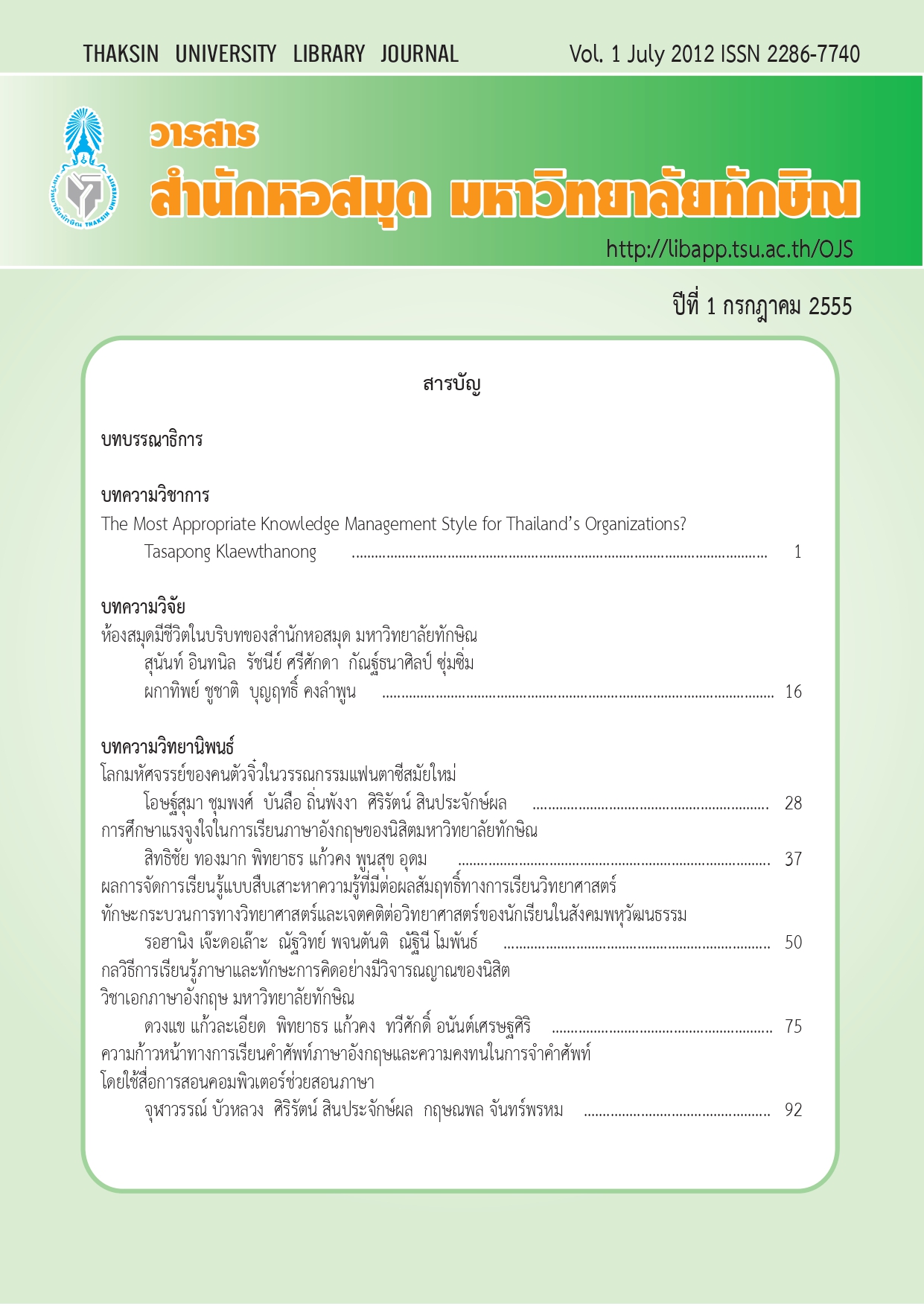Language Learning Strategies and Critical Thinking Skills of English Majors of Thaksin University
Keywords:
Language Learning Strategies, Critical Thinking Skills, High English Proficient Student, Low English Proficient StudentsAbstract
The objectives of this research were aimed 1) to investigate the levels and types of language learning strategies which are used by English major students 2) to investigate the levels and types of critical thinking skills which are used by English major student 3) to compare critical thinking skills used between high English proficient students and low English proficient students and 4) to investigate the relationship between the language learning strategies and the critical thinking skills of English major students. The target group was 134 second, third and fourth year English majors at Thaksin University in the 2011 academic year. The samples were divided into two groups: 36 high English proficient students and 36 low English proficient students using the 27% technique. The research instruments were questionnaires, critical thinking test and interviews. All the data collected were analyzed by using the SPSS program for frequency, percentage, arithmetic mean, standard deviation, t-test and Pearson correlation coefficient. Results revealed that 1) English major students generally applied all six language learning strategies (Memory, Cognitive, Compensation, Metacognitive, Social and Affective strategies) at a medium level of use. The majority of the students most used were Compensation strategies, With Memory strategies were the least level used. Similarly, students of high and low English proficient students employed Compensation strategies the most used and memory strategies the least frequently. 2) Students used critical thinking skills at the medium level, Induction was the highest level and observation and credibility of source was the lowest level. According to use of critical thinking skills in each class, the second year student’s critical thinking skills is at the medium level; the third year student’s critical thinking skills is at the medium level and the fourth year student’s critical thinking skills is at the medium level. 3) There was a significant difference between high and low English proficient students of the use of critical thinking skills at the confidence level of .01 4) Compensation strategies were correlated with Meaning at the confidence level .05, while Social strategies were correlated with Assumption Identification at the confidence level of .01 and also were correlated with Meaning at the confidence level of .05
References
กรมส่งเสริมสุขภาพจิต. (2545). รายงานการวิจัยเกี่ยวกับการทดสอบการพัฒนาทักษะชีวิตและการฝึกอบรมทักษะชีวิตในโรงเรียน. กรุงเทพฯ: กรมฯ.
ณรัน มุสิกบุญเลิศ. (2550). ความสัมพันธ์ระหว่างความสามารถในการคิดแก้ปัญหา ความสามารถในการคิดเชิงวิจารณญาณ และคุณลักษณะที่เอื้อต่อการวิจัยของนักศึกษาคณะครุศาสตร์/ศึกษาศาสตร์ระดับปริญญาตรี ของมหาวิทยาลัยในจังหวัดนครปฐม. วิทยานิพนธ์ ศึกษาศาสตรมหาบัณฑิต. นครปฐม : มหาวิทยาลัยศิลปากร.
ดรุณี บุญวิก. (2543). การศึกษาปัจจัยบางประการที่สัมพันธ์กับการคิดอย่างมีวิจารณญาณของนักเรียนชั้นมัธยมศึกษาปีที่ 3 จังหวัดนครศรีธรรมราช. วิทยานิพนธ์ การศึกษามหาบัณฑิต. กรุงเทพฯ : มหาวิทยาลัยศรีนครินทรวิโรฒ.
ทรงพล ศรัทธาอุดม. (2550). การสํารวจการใช้กลยุทธ์การเรียนรู้ภาษาอังกฤษ ของนักศึกษาชั้นปีที่ 1 มหาวิทยาลัยมหิดล. วิทยานิพนธ์ ศิลปศาสตรมหาบัณฑิต. กรุงเทพฯ : มหาวิทยาลัยมหิดล.
นฤมล โคตรสมบัติ. (2546). กรณีศึกษาการใช้กลวิธีการเรียนภาษาอังกฤษของนักศึกษา ระดับบัณฑิตศึกษา คณะวิทยาศาสตร์ มหาวิทยาลัยมหิดล เพื่อใช้ในการเรียนรู้ภาษาอังกฤษ. วิทยานิพนธ์ ศิลปศาสตรมหาบัณฑิต. กรุงเทพฯ : มหาวิทยาลัยมหิดล.
ละออง จันทร์พราวแสง. (2549). กลวิธีในการเรียนภาษาอังกฤษของนักเรียนชันมัธยมศึกษาปีที่ 3 โรงเรียนสตรีพร้อมพรรณวิทยา. วิทยานิพนธ์ ศิลปศาสตรมหาบัณฑิต. กรุงเทพฯ : มหาวิทยาลัยธรรมศาสตร์.
Abdullah, A. G. K., Alzaidiyeen, N. J. & Yee, N. M. (2010). “The practices of critical thinking component and its impact in Malaysian nurses health education,” International Education Studies. 3(1), 73 - 82. Retrieved November 19, 2010, from http://www.ccsenet.org/ies
Bayer, B. R. (1990). “What philosophy offers to the teaching of thinking,” Educational Leadership. 47(5), 55 - 60.
Cohen, J. (1988). Statistical power analysis for the behavioral sciences. Hillsdale, NJ : Erlbaum.
Ennis, R. H. (1985). “A logical basis for measuring critical thinking skills,” Educational Leadership. 43(2), 44 - 48.
Ennis, R.H., Millman, J. & Tomko, T.N. (2005). Cornell Critical Thinking Test Level X and Level Z Manual. Pacific Grove, CA : Midwest.
Feuerstein, R. (1980). Instrumental enrichment: An intervention programme for cognitive modifiability. Baltimore: University Park Press.
Hedges, L.E. (1991). Helping students develop thinking skills through the problem-solving approach to teaching. Ohio : The Ohio State University.
Hughes, A. (1989). Testing for language teachers. Cambridge : Cambridge University Press.
Magno, C. (2010). “Korean students’ language learning strategies and years of studying English as predictors of proficiency in English,” TESOL Journal. 2, 39 - 61. Retrieved May 8, 2010 from http://www.tesol-journal.com
McGregor, D. (2007). Developing thinking, developing learning. New York : McGraw-Hill House.
Methinee Wongwanich Rumpagaporn. (2007). Students’ critical thinking skills attitudes to ICT and perceptions of ICT classroom learning environment under the ICT schools pilots project in Thailand. Doctoral dissertation Doctor of Education. Australia : University of Adelaide.
Nikoopour, J., Farsani, M. A. & Nasiri, M. (2011). “On the relationship between critical thinking and language learning strategies among Iranian EFL learners,” Journal of Technology & Education. 5(3), 195 - 200. Retrieved March, 5, 2012, from http://www.sid.ir/en/VEWSSID/J-pdf/129120110303.pdf
O' Malley, J. M. & Chamot, A. U. (1990). Learning strategies in second language acquisition. Cambridge : Cambridge University Press.
Oxford, R. L. (1990). Language learning strategies: What every teacher should know. USA : Heinle & Heinle.
Paul, R. & Willsen, J. (1995). “Critical thinking: Identifying the targets,” In Paul, R. (Ed), Critical thinking: How to prepare students for a rapidly changing word. Santa Rosa, CA : Foundation of critical thinking.
Rost, M., & Ross, S. (1991). “Learner strategies in interaction : Typology and teachability” Language Learning. 41(2), 235 - 273.
Stern, H.H. (1992). Issues and options in language teaching. Oxford : Oxford University Press.


